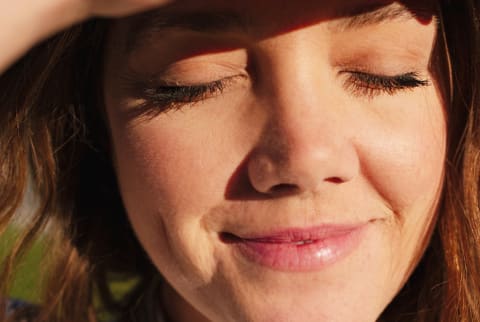Advertisement
This ad is displayed using third party content and we do not control its accessibility features.

Beauty & Health Editor
Beauty & Health Editor
Hannah Frye is the Beauty & Health Editor at mindbodygreen. She has a B.S. in journalism and a minor in women’s, gender, and queer studies from California Polytechnic State University, San Luis Obispo. Hannah has written across lifestyle sections including beauty, women’s health, mental health, sustainability, social media trends, and more. She previously worked for Almost 30, a top-rated health and wellness podcast. In her current role, Hannah reports on the latest beauty trends and innovations, women’s health research, brain health news, and plenty more.

Image by RZCREATIVE / Stocksy
September 02, 2024
We carefully vet all products and services featured on mindbodygreen using our
Our selections are never influenced by the commissions earned from our links.
Can your pores actually shrink? Well, not exactly. See, your pores don’t truly change in size, but the buildup within each pore can make it appear larger on the surface.
So the best way to actually “minimize” pores is to work on cleaning them out so there’s no gunk to exacerbate their appearance. To come, three products a dermatologist uses to do just that.
1.
Use BHAs in the morning
“I start with a BHA exfoliant,” says board-certified dermatologist Scott Walter, M.D., FAAD, in a recent TikTok video. BHA is short for beta-hydroxy acid, a type of exfoliant that can dive deeper into the pores than the gentler alpha-hydroxy acids (AHAs) to clean up the gunk.
He opts for the COSRX BHA Blackhead Power Liquid and uses it every morning, which also includes niacinamide to help regulate oil production and prevent pore buildup in the future.
However, sensitive skin types may experience irritation when using BHAs daily, so feel free to space it out if your skin begins to look inflamed, red, or dry, or it starts to itch.
Using BHAs, like salicylic acid, in the morning will ensure that you never mix it with retinol in the evenings, but it will make you more prone to sun damage and sunburn, so always apply SPF afterward.
2.
Use retinol 3 times a week
“Then at night at least three times per week I use a retinoid, like over-the-counter adapalene or prescription-strength tretinoin,” Walter notes.
This cadence can work for many people, but similar to the step above, it may be sensitizing for some skin types. Just stick to a cadence that supports your goals and skin barrier.
In addition, anyone just starting to use retinol should ease into it or apply it between layers of moisturizer to buffer the impact while your skin adjusts—this will help avoid retinol-induced irritation, peeling, etc.
“Then once a week I add a clay mask, which acts like a magnet for all the dirt, oil, and debris in the pores to help them look smaller,” he says while applying the PCA Skin Detoxifying Mask.
Most people can tolerate this step once a week unless their skin is super dry or sensitive. In that case, they should try adding this step to their biweekly routine.
Regardless, some clay masks are more drying than others. If your skin doesn’t usually respond well to simple clays, consider enhancing your formula with a bit of noncomedogenic oil, like jojoba oil, grapeseed oil, rosehip seed oil, etc., to soften the blow.
PSA
These ingredients are all considered “active” steps in your skin care routine and should be followed by moisturizer in the evening and sunscreen in the morning to tend to your skin barrier.
The takeaway
If you want your pores to appear smaller, you’ll have to start cleaning them out. A dermatologist recommends one A+ routine, featuring BHA exfoliants, regular retinol use, and a weekly clay mask. If you’re not sure how to space out these skin care products throughout the week, you may consider skin cycling—here’s everything you need to know.
